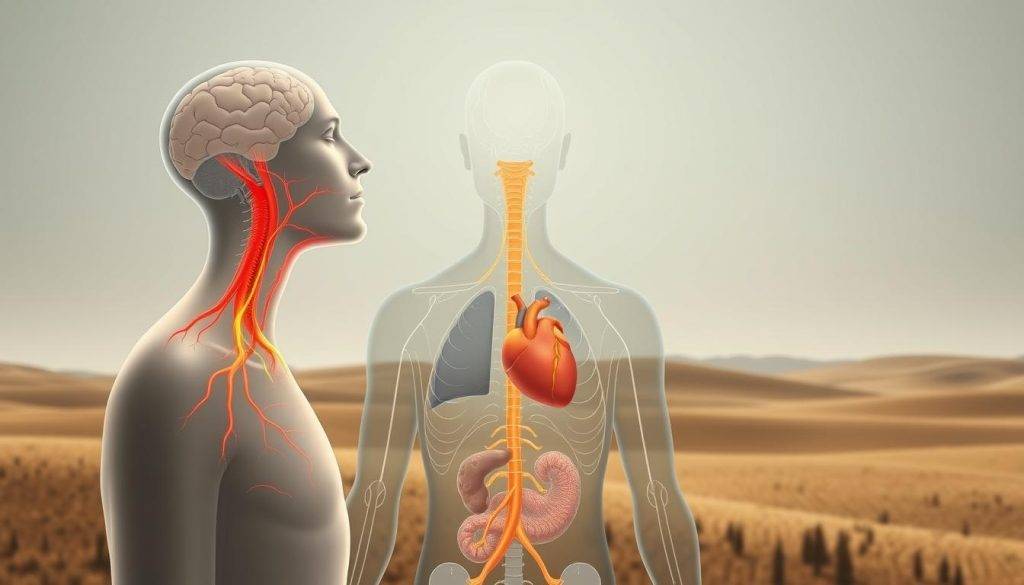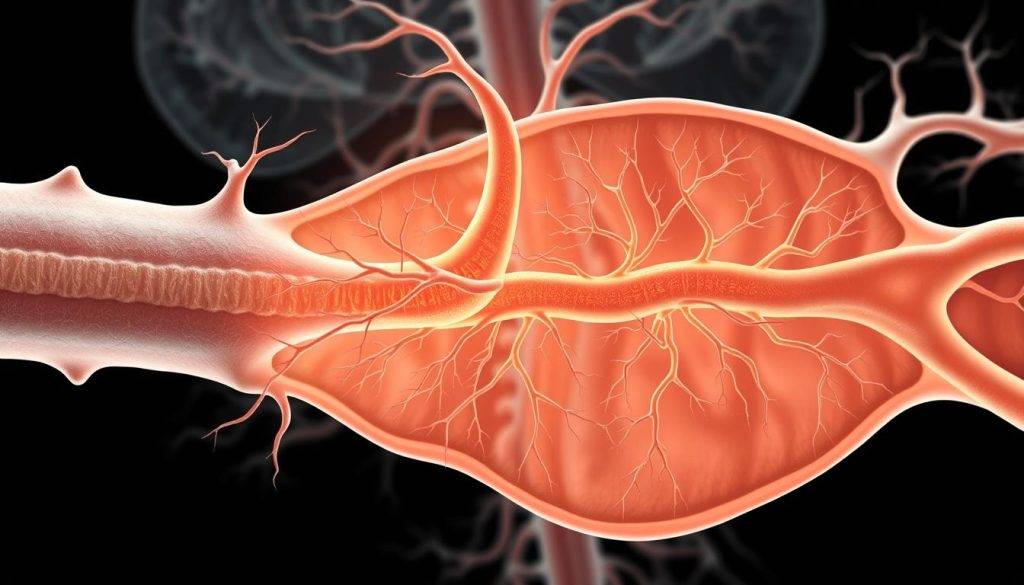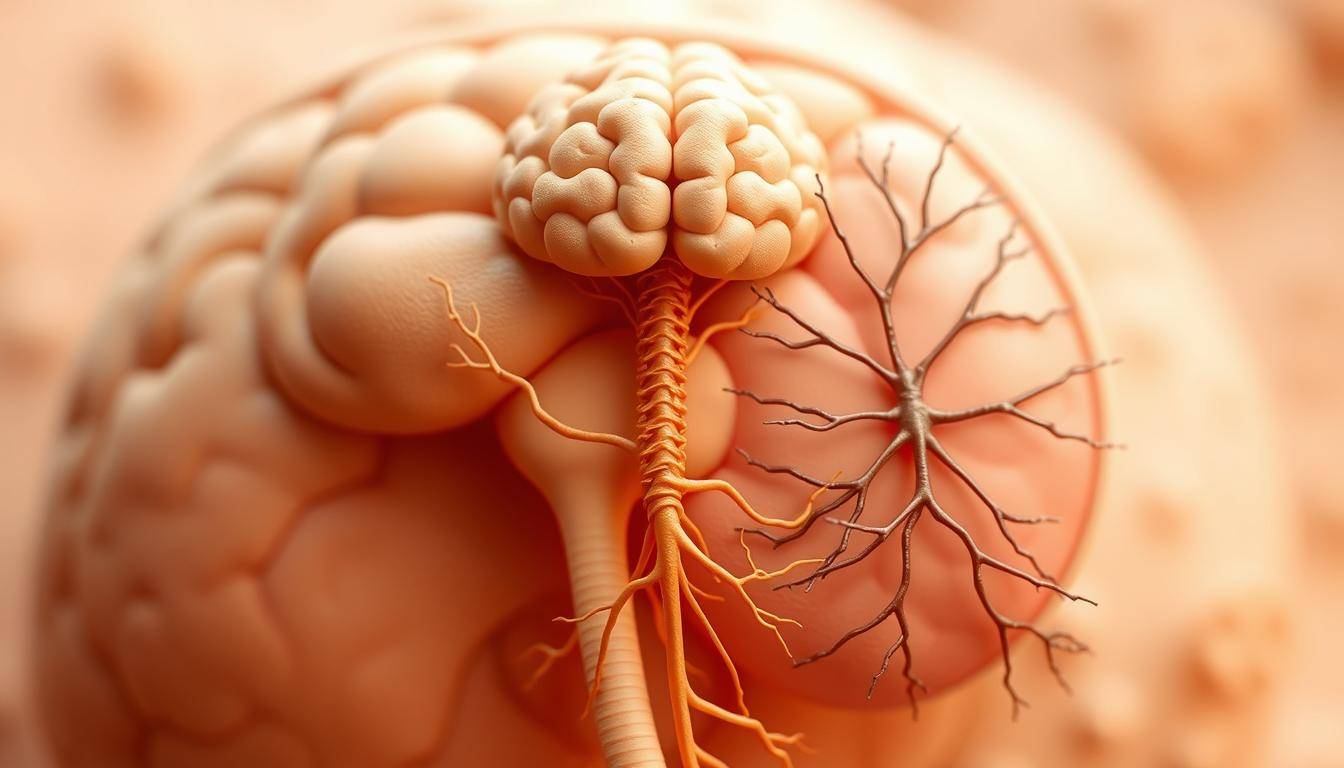“Safety is the most basic human need—without it, we cannot thrive.” This insight from Maya Angelou captures the essence of what it means to feel grounded in a chaotic world. Imagine unlocking a science-backed method to rewire your body’s responses to stress, fear, and overwhelm. That’s exactly what this guide offers.
At its core, this framework explores how our biology shapes emotions and behaviors. The vagus nerve—a key pathway connecting the brain to the body—acts like a switch, shifting us between states of calm alertness and survival-mode reactions. By understanding its role, you can learn to consciously influence your reactions to daily challenges.
This isn’t just theory. Practical strategies, grounded in neuroscience, empower you to create lasting safety in your body and mind. You’ll discover how small, intentional actions—like breathing techniques or mindful movement—can reset your entire nervous system. The result? Greater resilience, emotional balance, and the ability to navigate life’s ups and downs with clarity.
Ready to transform how you respond to stress? Let’s explore how to harness your body’s innate wisdom—and build a foundation of safety that supports every area of your life.
Key Takeaways
- Discover a science-backed approach to managing stress and emotional responses.
- Learn how the vagus nerve influences your body’s shift between calm and survival states.
- Gain actionable strategies to reset your nervous system in real-time.
- Understand the connection between biological processes and everyday well-being.
- Develop tools to create lasting feelings of safety and resilience.
Introduction to Polyvagal Theory and Its Self-Help Applications
The key to emotional balance lies in understanding the body’s hidden communication network. Developed by Dr. Stephen Porges in the 1990s, this science-backed framework reveals how our biology shifts between safety-focused social engagement and survival-driven reactions. It centers on the vagus nerve—a neural superhighway linking brain and body—and its role in managing stress responses.

From Survival to Connection
Dr. Porges’ work shows we cycle through three biological states: calm connection, fight-or-flight arousal, and shutdown. The sympathetic nervous system activates during perceived threats, but prolonged activation drains mental clarity. By recognizing these patterns, you gain power to reset your nervous system before stress escalates.
Why Personal Practice Matters
Investing time in these principles creates lasting change. Simple techniques—like mindful breathing or vocal toning—strengthen vagal tone, enhancing your capacity for resilience. Studies show consistent practice improves emotional regulation within weeks, making daily challenges feel manageable.
As Dr. Porges explains, “Safety isn’t just a feeling—it’s a biological state we can cultivate.” This approach bridges cutting-edge science with actionable self-care, offering tools to transform instinctive reactions into intentional responses.
Understanding the Neuroscience Behind Polyvagal Theory
Deep within our biology lies a nerve network that acts as your body’s command center for safety and threat responses. Dr. Stephen Porges’ research reveals how the vagus nerve—the longest cranial nerve—orchestrates this delicate balance through two distinct branches. These pathways work like biological traffic lights, guiding your nervous system toward connection or protection.

The Role of the Vagus Nerve in Body Regulation
The ventral vagal circuit acts as your social engagement system. It calms heart rate, supports clear thinking, and helps you connect with others. When active, your body releases calming chemicals, creating a “green light” state for growth and healing.
In contrast, the dorsal vagal pathway triggers shutdown during overwhelming stress. This ancient survival mechanism slows bodily functions—like a circuit breaker flipping off. While protective, prolonged activation can leave you feeling disconnected or numb.
Exploring the Three Neural Circuits
Your nervous system navigates three primary states:
- Safety and connection (ventral vagal): Ideal for learning, creativity, and healthy relationships
- Mobilized defense (sympathetic nervous system): Prepares for quick action during perceived danger
- Shutdown (dorsal vagal): Conserves energy when threats feel inescapable
The brain constantly scans for safety cues through facial expressions and vocal tones. Eye contact, for instance, can signal safety to the ventral vagal network. As Porges notes, “Our biology listens before we consciously hear.” This explains why calming practices like humming—which vibrates the vagus nerve—create rapid shifts in emotional states.
Polyvagal Theory Self-Help: A Practical Approach
Your body communicates through biological signals that reveal your current state of safety or stress. Recognizing these cues helps you intervene before stress escalates. Start by tuning into physical sensations: a calm heartbeat and relaxed muscles signal social engagement, while rapid breathing or tension often indicate fight flight activation.

Identifying Nervous System States: Social Engagement, Fight/Flight, and Freeze
Three distinct patterns emerge:
- Social engagement: Steady breathing, warm skin, and easy eye contact
- Fight/flight: Racing thoughts, sweating, or muscle tightness
- Freeze: Numbness, slowed movements, or disconnection
Clinical research shows resonant breathing—inhaling for 4 seconds and exhaling for 6—directly calms the sympathetic nervous system. This technique works by stimulating the vagus nerve, shifting your body from defense mode to safety.
Insights from Clinical and Self-Help Perspectives
When activation occurs, try these ways to reset:
- Humming or singing to vibrate the vagus nerve
- Cold water splashed on the face (triggers the dive reflex)
- Grounding exercises like naming five objects in your environment
While self-help strategies empower daily coping, working with a therapist provides tailored support for chronic patterns. As one study notes: “Combining personal practice with professional guidance yields the strongest outcomes.”
Engaging others through safe social interactions can amplify these techniques. Simple acts like sharing a meal or laughing with friends reinforce biological safety signals, proving that healing often happens in connection.
Impact on Emotional and Physical Wellbeing
Your body’s internal wiring directly shapes how you experience emotions and physical sensations. When the nervous system stays stuck in survival state, it alters brain chemistry—increasing stress hormones like cortisol while reducing mood-stabilizing serotonin. Research shows chronic activation doubles the risk of depression and heightens anxiety symptoms over time.

How the Nervous System Influences Mood and Behavior
Consider this: 80% of serotonin production occurs in the gut, which communicates with the brain via vagus nerve pathways. A dysregulated system disrupts this dialogue, creating a cycle of emotional turbulence. Physical signs like muscle tension or digestive issues often mirror this imbalance, proving how deeply body and mind intertwine.
Clinical studies reveal that prolonged fight-or-flight activation shrinks the prefrontal cortex—the brain region responsible for rational decision-making. This explains why chronic stress makes individuals more reactive and less capable of emotional rest.
Linking Sympathetic Activation With Fight or Flight Responses
When survival mode dominates, the nervous system prioritizes immediate protection over long-term health. Heart rates spike, breathing shallowens, and blood sugar rises—all preparing you to outrun danger. But modern stressors like work deadlines or financial worries keep this state active indefinitely.
Persistent activation erodes emotional resilience. As noted in Psychosomatic Medicine: “Unmanaged stress responses become neural habits that reshape brain structure.” This underscores why intentional coping strategies—like those explored in how your nervous system affects manifestation—are vital for restoring equilibrium.
Rebalancing your system creates ripple effects. Improved sleep quality, stabilized moods, and sharper focus all stem from regulated biological order. By addressing root causes rather than symptoms, you build sustainable foundations for daily life challenges.
Applying Practical Techniques to Regulate Your Nervous System
Mastering your body’s natural rhythms begins with accessible tools that fit seamlessly into daily routines. These science-backed methods help shift your biological state from survival mode to calm engagement, creating lasting resilience against stress triggers.

Everyday Exercises for Vagal Stimulation
Start with deep diaphragmatic breathing: Inhale for 4 seconds, exhale for 6. This simple rhythm activates the vagal nerve, slowing heart rate within minutes. Pair it with gentle neck rotations—slow side-to-side movements release tension in key nerve pathways.
Try resonant breathing before meals or during breaks. Research shows this technique boosts nervous system regulation by 37% when practiced consistently. For quick resets, hum a low tone while massaging the area behind your ears—a direct way to stimulate vagal fibers.
Integrating Principles Into Daily Life
Turn routine activities into regulation tools. Chew meals slowly to engage digestive-linked vagal pathways. Practice “soft eye” focus during conversations—this subtle shift signals safety to your body. Even laughter counts: sharing jokes with friends triggers positive responses in the ventral vagal network.
Explore research-backed methods like brainspotting or bilateral tapping. These skills help process stored stress without overwhelming your system.
Technology-Assisted Support
Neurofeedback devices like NeurOptimal® train your brain to self-regulate during stress spikes. Pair sessions with guided podcasts focused on somatic exercises—many offer 10-minute resets perfect for busy schedules.
Cold exposure apps track progress in building stress tolerance. For chronic activation, combine tech tools with weekly therapy. As noted in emotional reset guides, layered approaches yield faster results than single solutions.
Conclusion
True empowerment begins when we decode our body’s language of safety. Through intentional practice—like resonant breathing or mindful engagement—you can reshape automatic responses rooted in survival states. These tools activate the vagus nerve, helping shift from fight flight reactions to grounded clarity.
Consistent effort creates lasting change. Studies show dedicating time to vagal stimulation strengthens emotional resilience and physical health. Whether through cold exposure or connecting with others, small actions rebuild trust in your nervous system’s ability to self-regulate.
This science-backed approach bridges biology and daily coping. By recognizing early signs of activation, you prevent chronic stress from hijacking your brain and body. Resources like guided podcasts or expert-led workshops deepen this transformative work.
Your journey toward balance is ongoing—and profoundly personal. Each choice to prioritize rest or seek social engagement rewires neural pathways for sustainable well-being. Start today: explore one technique, track shifts in your states, and witness how reclaiming safety transforms every aspect of life.




























































